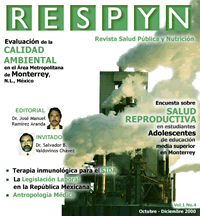Terapia inmunológica para el SIDA
Resumen
Los enfoques farmacológico e inmunológico para nuevasintervenciones en la infección por VIH han llevado a
analizar el efecto alentador de nuevos agentes y a la
combinación potencial de los mismos. El reto es definir
cuales estrategias pueden resultar en beneficios clínicos de
largo plazo con un mínimo de toxicidad. El papel de la
terapia inmunológica debe ser cuidadosamente entendido
en el ámbito continuamente cambiante de los nuevos
medicamentos antirretrovirales
Descargas
Citas
Senior K. 1999, New drug makes host cell machinery unavailable to HIV. Mol Med Today;
:234-5.
Kiessling R, G Pawelec, RM Welsh, JD Barry, S Ferrone. Have tumor cells learnt from
microorganism how to fool the immune system? Mol Med Today 2000; 6:344-6.
Alcami A, UH Koszinowski. 2000, Viral mechanisms of immune evasion. Mol Med Today; 6:365-
Tortorella D, BE Gewurz, MH Furman, DJ Schust, HL Ploegh, 2000. Viral subversion of the
immune system. Annu Rev Immunol.; 18:861-926.
Kiessling, op. cit.
Idem
Tortorella, op.cit.
Kalvakolanu DV. 1999, Virus interception of cytokine-regulated pathways. Trends Microbiol;
:166-71.
Goodbourn S, 2000. Interferons: Cell signaling, immune modulation, antiviral responses and
virus countermeasures. J Gen Virol; (en prensa).
Mahr JA, LR Gooding. 1999 Immune evasion by adenoviruses. Immunol Rev; 168:121-30.
Albini A, S Ferrini, R Benelli, S Sforzini, D Giunciuglio, MG Aluigi, AE Proudfoot, S Alouani, TN
Wells, G Mariani, RL Rabin, JM Farber, DM Noonan 1998. HIV-1 Tat protein mimicry of
chemokines. Proc Nat Acad Sci USA; 95:13153-8.
Tortorella, op.cit
Spriggs MK. 1996. One step ahead of the game: viral immunomodulatory molecules. Annu
Rev Immunol; 14:101-30.
Fruh K, A Gruhler, RM Krishna, GJ Schoenhals 1999. A comparison of viral immune escape
strategies targeting the MHC class I assembly pathway. Immunol Rev; 168:157-66.
Farell HE, NJ Davis-Poynter 1998. From sabotage to camouflage: Viral evasion of cytotoxic T
lymphocyte and natural killer cell-mediated immunity. Sem Cell Dev Biol.; 9:369-78. 16. Plemper
RK, DH Wolf 1999. Retrograde protein translocation: Erradication of secretory proteins in health
and disease. Trends Biochem Sci; 24:266-70.
Moss RB, W Giermakowska, MR Wallace, J.R. Savary, F. C. Jensen, D. J. Carlo 2000. Cellmediated
immune responses to autologous virus in HIV-1 seropositive individuals after treatment
with the HIV-1 immunogen (REMUNE). (Abstract 583) 40th Interscience Conference on
Antimicrobial Agents and Chemotherapy, Toronto. American Society for Microbiology, 292.
Moss RB, J Diveley, E Gouveia, F.C.Jensen, D.J. Carlo, 2000. HIV-specific immune
responses are generated with a combination of gp120-depleted, whole-killed HIV-1 immunogen
with CpG immunostimulatory sequences of DNA. (Abstract: 584).40th Interscience Conference on
antimicrobial agents and chemotherapy, Toronto. American Society for Microbiology, 292.
Luscher MA, L Matukas, B Livingstone, a. Setter, R. Kaul, J. Kimani, P. Kiama j.j. Byayo, F.A.
Plummer, K. S. Macdonalds. Immunogenicity of conserved HIV-1 epitopes restricted by HLA
supertypes associated with resistance to HIV-1 infection among sex workers: significance for
vaccine design. (Abstract: 581). 40th Interscience Conference on Antimicrobial Agents and
Chemotherapy, Toronto. American Society for Microbiology, 291.
Borysiewicz LK. 2000; Laboratory techniques for measurement of T cell responses to viruses.
(Abstract: 2088). 40th Interscience Conference on Antimicrobial Agents and Chemotherapy,
Toronto. American Society for Microbiology, 547.
Phillips RE, 2000. Evasion of early immune responses by persistent viruses: Lessons from
HCV and HIV. (Abstract: 2091). 40th Interscience Conference on Antimicrobial Agents and
Chemotherapy, Toronto. American Society for Microbiology, 547.
Moss (17)
Kahn J, S Lagakos, K Mayer, H Murray. A 1999; randomized, placebo controlled multicenter
study of Remune in subjects with 300-550 CD4 cells and unrestricted anti-retroviral
treatments. (Abstract: LB-21) 39th Interscience Conference on Antimicrobial Agents and
Chemotherapy, San Francisco. American Society for Microbiology.
Koup RA, JT Safrit, Y Cao, CA Andrews ,G McLeod, W Bokowsky, C Farthing, DD Ho
Temporal association of cellular immune responses with initial control of viremia in primary
HIV-1 syndrome. J Virol; 68:4650-5.
Safrit JT, CA Andrews, T Zhu, DD Ho, RA Koup 1994. Characterization of HIV-1 specific
cytotoxic T lymphocyte clones isolated during acute seroconversion: recognition of autologous
virus sequences within conserved immunodominant epitope. J Exp Med; 179:463-72.
Luzuria K, RA Koup, CA Pikora, DB Brettler, JL Sullivan 1991. Deficient HIV-1 specific
cytotoxic T cell responses in vertically infected children. . J Pediatr; 119:230-6.
Pantaleo G, JF Demarest, H Soudeyns, C Graziosi , F. Denis , JW Adelsberger, P Borrow, MS
Saag, Shaw GM, Sekaly RP, Fauci AS. 1994. Major expansion of CD8+ T cells with predominant
Vb usage during the primary immune response to HIV. Nature; 370:463-7.
Safrit, op.cit.
Descargas
Publicado
Cómo citar
Número
Sección
Licencia
Los derechos del trabajo pertenecen al autor o autores, sin embargo, al enviarlo a publicación en la Revista Salud Pública y Nutrición de la Facultad de Salud Pública y Nutrición de la Universidad Autónoma de Nuevo León, le otorgan el derecho para su primera publicación en medio electrónico, y posiblemente, en medio impreso a la Revista Salud Pública y Nutrición. La licencia que se utiliza es la de atribución de Creative Commons , que permite a terceros utilizar lo publicado siempre que se mencione la autoría del trabajo y a la primera publicación que es en la Revista Salud Pública y Nutrición. Asimismo, el o los autores tendrán en cuenta que no estará permitido enviar la publicación a ninguna otra revista, sin importar el formato. Los autores estarán en posibilidad de realizar otros acuerdos contractuales independientes y adicionales para la distribución no exclusiva de la versión del artículo publicado en la Revista Salud Pública y Nutrición (p. ej., repositorio institucional o publicación en un libro) siempre que indiquen claramente que el trabajo se publicó por primera vez en la Revista Salud Pública, Revista de la Facultad de Salud Pública y Nutrición de la Universidad Autónoma de Nuevo León.










